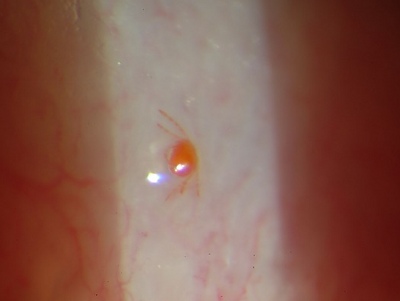Harvest mite
Harvest mites are mites within the Family Trombiculidae. They are perhaps most well known for their parasitic larvae called Chiggers. The larvae feed on skin cells of the host. This is done by piercing the skin and injecting digestive enzymes under the skin. The enzymes break down the skin cells which the larvae then consumes. This process produces a reaction in the host and usually results in swelling, pimples and considerable irritation. Chiggers, the mite larvae, do not burrow in to the skin or feed on blood as is often assumed.
The adult mites and larvae are often given many different common names depending on the region of the world in which they occur.

A photograph of a Neotrombicula autumnalis mite in contact with the left upper eyelid margin. The parasitic larvae of these mites are commonly known as Chiggers.
Photograph from Parcell, B. J., Sharpe, G., Jones, B. & Alexander, C. L. 2013: Conjunctivitis induced by a red bodied mite, Neotrombicula autumnalis. Parasite, 20, 25.
Image licensed under Creative Commons.
Other names for (or types of) Harvest mite include:
- Berry bugs
- Chiggers
- Scrub-itch mites
Related terms
Related pages on this web site
Back to Glossary
If you have found this glossary useful please consider supporting the Amateur Entomologists' Society by becoming a member or making a donation.
![Amateur Entomologists' Society home page [Logo]](/images/aes-logo-wplant.gif)